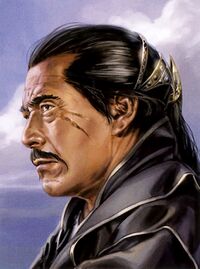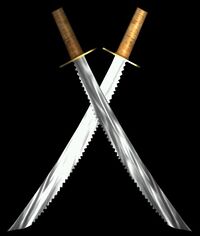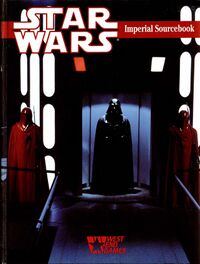Atrisia/Legends
- "Look at the Atrisi system, for example. The principal planet still recalls the Kitel Phard Dynasty with pride. These rulers unified the entire homeworld, eliminating opposition and establishing a golden age."
- ―Major Arhul Hextrophon
Atrisia, also known as Kitel Phard, was a terrestrial planet located in the Core Worlds sector known as the Atrisian Commonwealth. It lay on the Giju Run hyperlane and was the homeworld of the creature known as the shredder bat. Locations on the planet included the city of Jar'Kai and the Atrisian Imperial Historical Library.
Atrisia was inhabited by a race of Humans known as the Atrisians. During their homeworld's ancient history, the Atrisians had formed several nations, including the Atrisian Empire, which actively engaged in conquests. Under the leadership of the fifty-forth Atrisian Emperor, Uueg Tching, the Empire's Kitel Phard Dynasty unified the planet, and Atrisia was subsequently also referred to as "Kitel Phard." Tching also authored a collection of parables, analogies, and instructions known as the Sayings, which began to circulate in the wider galaxy millennia later.
By 24,500 BBY, a type of dueling sword and an associated dual-wielding sword-fighting technique was developed in the Atrisian city of Jar'Kai. At the conclusion of the First Great Schism around the same time, the Legions of Lettow member Arden Lyn traveled beyond Atrisia while fleeing the forces of the Jedi Order.
Nearly twenty-four millennia later, the Atrisian Parliament took over power from the planet's emperors. Atrisia subsequently became a part of the Galactic Republic, by which time its ancient history was considered a classical field of galactic historical studies. The achievements of the Atrisian Empire served as an inspiration for the formation of the Galactic Empire, of which the planet became a member. Atrisia also joined the Empire's successor, the New Republic, and fell within the borders of Darth Krayt's Galactic Empire a century later.
Description
- "The predator known as the shredder bat was first encountered on the ancient planet of Atrisia; […]."
- ―Holobrochure for the Tagge Holographic Museum of Chandrila
Atrisia, also occasionally referred to as Kitel Phard,[1] was the principal[2] planet[1] of the Atrisi system.[2] It was a part of the Atrisian Commonwealth, a sector of space in the Southern Core portion of the Core Worlds.[1]
The planet lay at the endpoint of the hyperlane known as the Giju Run, which, after a short detour through the Colonies, connected Atrisia to the Core Worlds' Dahrtag system.[1] Additionally, a set of hyperspace routes led beyond Atrisia, connecting it to a tangle of stars and, ultimately, the astronomical object Irkalla[7] in the Unknown Regions.[8]
Atrisia was a terrestrial world with several continents on its surface.[2] The predatory creature known as the shredder bat was first encountered on the planet but eventually spread to more than a thousand other worlds.[4]
History
The Kitel Phard Dynasty
- "Uueg increased the Atrisian Empire to rule, directly or indirectly, the whole of Kitel Phard."
- ―Lecture by Doctor Corellia Antilles
Atrisia was colonized by Humans.[1] The state known as the Atrisian Empire, led by the First Atrisian Emperor,[9] was among several nations formed on the planet,[2] and the early rulers of that empire carried out brutal conquests.[9] Bloody wars ensued, with the Third Atrisian period being a particularly tumultuous time in the planet's history.[5]

The emperors of the Kitel Phard Dynasty subsequently carried out the process of eliminating any opposition and unifying Atrisia.[2] That unification was completed during the rule of the fifty-fourth Atrisian Emperor, Uueg Tching.[5] During his reign, Tching enjoyed successes against the nations inhabiting the recently discovered continents of the planet.[2] Upon his victory over the last of Atrisia's continents,[9] Tching had expanded the Atrisian Empire to rule, directly or indirectly, over the entirety of his homeworld[5] and had also established planetwide use of the writing system known as the Atrisian script.[9]
The fifty-fourth Emperor of Atrisia became famous for his tyrannical rule and his insight into strategy, diplomacy, and the effective use of spies[3] and subverted more than thirty separate rebellions against his rule.[2] Atrisian court[9] scribes hand-recorded the Sayings, a collection of instructional parables, analogies, and advice that Tching compiled as a guide for his successors.[5] In time, Tching became a legendary ruler,[2] with the following Tching Dynasty being named after him,[5] and later Atrisians remembered with pride[2] both him[5] and the Kitel Phard Dynasty as a whole. The dynasty's actions ushered in a golden age,[2] and Atrisia was later occasionally referred to as "Kitel Phard" after those rulers.[1]
Planet of Twin Swords
- "I fled into the tangled stars beyond Kitel Phard, following secret ways Xendor had discovered."
- ―Arden Lyn

By 24,500 BBY,[10] pairs of specific dueling swords were first crafted in the city of Jar'Kai on Atrisia. The Yovshin Swordsmen of the Atrisian Empire named those weapons after the settlement, and their dual-wielding sword-fighting technique using the paired blades[6] was also developed in the city.[11] Around that same year,[12] Xendor, the leader of the Legions of Lettow, discovered a number of secret hyperlanes leading beyond Atrisia. When the First Great Schism concluded with the Jedi Order attacking the Legions at Lettow, several of the Legionnaires fled and left the borders of the Galactic Republic. Arden Lyn, the former lover of the deceased Xendor, sought refuge in space beyond Atrisia but was eventually cornered by the Jedi on Irkalla.[7]
The Atrisians eventually left their homeworld, which became one of the approximately 200 settled worlds known as the Atrisian Commonwealth. The area of space surrounding Atrisia was explored by the Galactic Republic at some point between 5000 BBY and 3996 BBY and thus became part of what was considered the civilized galaxy. Contact with the independent Atrisian Commonwealth led to the growth of the Southern Core, a region of the Core Worlds and the Colonies.[1]
By 3643 BBY,[13] weapon masters on Atrisia intended to test their students by having them face battle-hardened fighters, the latter of which the masters found themselves in need. An individual subsequently dispatched a companion to recruit skilled warriors who were up to the task posed by the Atrisian weaponsmiths. The companion discovered a group of captured warriors affiliated with the[14] ancient Morgukai order[15] and delivered them to Korriban,[14] an Outer Rim planet[1] housing the Sith Academy of the reconstituted Sith Empire.[16] No more than five years later,[17] a treasure hunter claimed to have discovered Jar'Kai swords belonging to one of the first Yovshin Swordsmen. An interested party then sent a companion to confirm that the find was genuine.[18]
The Parliament and the Republic
- "After spending over two millennia available only to the nobility, the Parliament showed the authority it had finally wrested from the throne by reproducing the Sayings in both a database format and special printed edition. Now widely available, the Sayings began making their way off of the planet."
- ―Doctor Milanda Vorgan, "The Written Word: A Brief Introduction to the Writing Systems of Galactic Basic"

One of the emperors of Atrisia eventually ordered the printing of Uueg Tching's Sayings in a limited run intended for the Atrisian nobility. Furthermore,[5] around 539 BBY,[19] the Atrisian Parliament, having wrested power from the imperial throne, made the Sayings available in both a specially printed edition and a database format.[5] Subsequently, both the collection and the Atrisian script it had been written in began to make their way offworld.[9]
Approximately 500 years later,[20] the Atrisian Empire had become a classical field of galactic historical studies at the University of Coruscant.[21] In addition, despite space surrounding Atrisia being a part of the territories either unaligned with or contested by the Galactic Republic or the Brotherhood of Darkness by 1000 BBY, the planet fell within the borders of the Republic during the Clone Wars of 22 BBY–19 BBY.[1] During the first campaigns of that conflict, the Twentieth Army of the Republic Military was tasked with defending Atrisia's vicinity against the military forces of the Confederacy of Independent Systems,[7] and the Republic Navy included the Dreadnaught-class heavy cruiser Atrisian Iron by the date 15:2:29.[22]
Galactic Empire
- "Most people associate the Atrisian Empire with exotic danger—the brutal conquests of its early rulers, the brilliant but ruthless political gambits of Emperor Uueg Tching, the distilled political craftiness of his Sayings, or the sociopathic decadence of the Six Savage Viziers. While the modern Atrisian Commonwealth is a far more mundane place, Atrisian script, the writing system made ubiquitous planetwide by the Kitel Phard Dynasty, has found a place offworld in hands every bit as pitiless as the ancient emperors."
- ―Doctor Milanda Vorgan, "The Written Word: A Brief Introduction to the Writing Systems of Galactic Basic"

The Kitel Phard Dynasty of Atrisia served as an inspiration for the formation of the Galactic Empire.[23] In his rhetoric addressed at the senators of that newly founded regime, Galactic Emperor Palpatine promised to bring about a galactic golden age akin to that achieved by the ancient rulers of Atrisia.[24] By 17 BBY, Atrisia lay within space controlled by the Empire,[7] and certain elements of the Imperial Military were named after aspects of the ancient Atrisian civilization, such as the atrisian corps of the Imperial Army[25] and the military title Warlord of the Empire.[26] The planet was mentioned in a holobrochure for the Tagge Holographic Museum of Chandrila,[4] and, shortly after the Battle of Yavin, the Rebel Alliance historian Major Arhul Hextrophon noted the history of Atrisia in a compilation of Imperial documents for Alliance Supreme Commander Mon Mothma and other Rebel officers.[2]
Following the death of Palpatine at the Battle of Endor in 4 ABY, Atrisia declared its independence from the Empire, and the Atrisian Commonwealth eventually joined the Empire's successor government, the New Republic, as an Allied Region.[1] The xenoarchaeologist Doctor Corellia Antilles mentioned Atrisia in a lecture given at the Galactic Museum on[5] the Core Worlds planet Coruscant[1] approximately seven years later.[27] In 38 ABY, the world was also featured in the xenolinguist Doctor Milanda Vorgan's publication "The Written Word: A Brief Introduction to the Writing Systems of Galactic Basic." In[9] her[28] work, Vorgan noted that most people had since come to associate the ancient Atrisian Empire with exotic danger, especially when compared with the state of the modern Commonwealth.[9] By 137 ABY,[1] the ancient planet[4] Atrisia had been incorporated into the Core Worlds Security Zone, an administrative territory of Darth Krayt's Galactic Empire.[1]
Inhabitants
- "An enlightened despot, he [Uueg Tching] is remembered by Atrisians for his skill in diplomacy, in war, and in maintaining order."
- ―Lecture by Doctor Corellia Antilles
Atrisia was populated by a Human race known as Atrisians, with the population of the Atrisi system around 25 ABY numbering from 100 million to 500 million.[1] Before Tching's Atrisian Empire unified the planet,[5] Atrisia's continents were inhabited by several nations.[2] The Atrisian mythology included Wapoe, a demigod of disguise.[29] Upon the unification of Atrisia by the Kitel Phard Dynasty, the use of the standardized Atrisian script was established planetwide.[9]
Ancient Atrisia was a highly militarized society, and the atrisian corps of the later Galactic Empire was named in honor of the Atrisian warriors of the Kitel Phard Dynasty.[25] However, the composition of the collection known as Sayings by Emperor Tching marked a change in Atrisian politics from bloody wars to infiltration, espionage, and assassination. Eventually, the Atrisian Parliament took over power formerly held by the imperial throne, but centuries later, the Atrisians still remembered[5] the Kitel Phard Dynasty[2] and Tching with pride.[5]
Despite eventually achieving interstellar spaceflight, the Atrisians remained an insular culture, although some left their homeworld for the wider galaxy,[1] such as Rom Mohc,[9] who served with the Republic Military during the Clone Wars[30] and eventually became a general in the Galactic Empire's military forces.[31] By the time of the Galactic Civil War, there were several noble families of Atrisians, one of which included Villis Andal, who eventually became a Moff of the Galactic Empire.[32]
Locations
- "The original manuscript of Uueg Tching's Sayings was kept for the last 3,000 years in the Rare Books Department of the Atrisian Imperial Historical Library on Kitel Phard."
- ―Lecture by Doctor Corellia Antilles
The city of Jar'Kai was located on Atrisia. The Yovshin Swordsmen named swords crafted in that settlement "Jar'Kai," and the name also came to refer to the sword-fighting technique utilizing those weapons.[6] Atrisia was also the site of the Atrisian Imperial Historical Library. The original manuscript of Uueg Tching's Sayings was kept in the Rare Books Department of the library[3] for 3,000 years[5] before it was transferred to the Imperial Museum on Coruscant[3] around 1 BBY.[33]
Behind the scenes
- "Atrisia is from the Imperial Sourcebook; Kitel Phard is from Adventure Journal #14. Making them one and the same seemed logical—the Imperial Sourcebook is clear about the fact that Uueg Tching united a planet. Atrisia's antiquity and apparent importance to galactic culture argued for putting it in the Core Worlds; we stuck it out on the frontier to give it more of a whiff of the exotic and in hopes that future Star Wars creators might find intriguing possibilities in that."
- ―Jason Fry

Atrisia was introduced in the Imperial Sourcebook, a 1989 supplement written by Greg Gorden for West End Games' Star Wars: The Roleplaying Game. Although the book mentioned "Uueg Tching of Kitel Phard, 54th Emperor of Atrisia," it also introduced the Kitel Phard Dynasty and thus did not definitively establish the nature of the aforementioned "Kitel Phard."[35] In August 1997, the article "From the Files of Corellia Antilles," which was authored by Timothy O'Brien and published in Star Wars Adventure Journal 14, established that Kitel Phard was an astronomical object.[5] When writing The Essential Atlas,[34] a reference book by Daniel Wallace and Jason Fry released in 2009,[1] co-author Fry felt that it was "logical" to conclude that Atrisia and Kitel Phard referred to the same planet,[34] and thus the two were established by the book to be synonyms.[1]
In addition, due to previously published sources noting Atrisia's antiquity and its cultural importance to the wider galaxy, the authors of The Essential Atlas decided to place the planet in the Core Worlds region of the galaxy,[34] albeit on the very frontier of that region as part of grid square J-12—near the border of the explored galactic territories.[1] This was done intentionally to make Atrisia seem a more exotic location and to provide the authors of future Star Wars media with interesting storytelling possibilities.[34] "Twinkle, Twinkle Little Star, How I Wonder Where We Are," a 1990 roleplaying game source article published in Voyages SF 13, had previously placed the Atrisi system in the Harron sector. Since the article was released outside of the Lucas Licensing process, its canonicity within the Star Wars Legends continuity was never confirmed,[36] and The Essential Atlas overrode the Voyages SF 13 placement by establishing that the Atrisi system, and therefore Atrisia, was situated outside of the Expansion Region[1] in which the Harron sector was later placed.[37]
According to an outline for Fry and Paul R. Urquhart's 2012 reference book, The Essential Guide to Warfare, that book would have detailed the military conflicts taking place on Atrisia. However, the relevant sections, "The Wars of Atrisia" and "World at War: Atrisia," were ultimately not written.[38]
Appearances
- Star Wars: The Old Republic (Mentioned only)
- Star Wars: The Old Republic: Rise of the Hutt Cartel (Mentioned only)
- The New Jedi Order: Force Heretic I: Remnant (Mentioned only) (Epigraph)
Sources
- Imperial Sourcebook (First mentioned)
- Imperial Sourcebook, Second Edition
- Creatures of the Galaxy
 "From the Files of Corellia Antilles" – Star Wars Adventure Journal 14 (First identified as Kitel Phard)
"From the Files of Corellia Antilles" – Star Wars Adventure Journal 14 (First identified as Kitel Phard) "The Dark Forces Saga, Part 4" (original article link) on Wizards.com (content now obsolete; backup link)
"The Dark Forces Saga, Part 4" (original article link) on Wizards.com (content now obsolete; backup link)- The Complete Star Wars Encyclopedia
- The Essential Atlas (First confirmation of "Atrisia" and "Kitel Phard" as synonyms)
 The Written Word on Hyperspace (article) (content removed from StarWars.com; backup link) (Indirect mention only)
The Written Word on Hyperspace (article) (content removed from StarWars.com; backup link) (Indirect mention only)- The Essential Guide to Warfare
- Star Wars: Edge of the Empire Core Rulebook
- Star Wars: Age of Rebellion Core Rulebook
 Star Wars: The Essential Guide to Warfare Author's Cut, Part 12: Tales of the New Republic on StarWars.com (article) (backup link not verified!)
Star Wars: The Essential Guide to Warfare Author's Cut, Part 12: Tales of the New Republic on StarWars.com (article) (backup link not verified!)- Star Wars: Force and Destiny Core Rulebook
Notes and references
External links
 Daniel Wallace's Geekosity — Endnotes for Star Wars: The Essential Atlas (part 1 of 5) on Blogspot (backup link)
Daniel Wallace's Geekosity — Endnotes for Star Wars: The Essential Atlas (part 1 of 5) on Blogspot (backup link) Daniel Wallace's Geekosity — Endnotes for Star Wars: The Essential Atlas (part 2 of 5) on Blogspot (backup link)
Daniel Wallace's Geekosity — Endnotes for Star Wars: The Essential Atlas (part 2 of 5) on Blogspot (backup link)
- Pages with ignored display titles
- Pages with missing permanent archival links
- Pages with broken file links
- Pages with bad parameters in Template:Top
- Articles with gameplay alternatives
- Broken Mediacat category links
- Atrisia locations
- Atrisian Commonwealth planets
- Core Worlds planets
- Darth Krayt's Galactic Empire planets
- Galactic Empire planets
- Galactic Republic planets
- Terrestrial planets